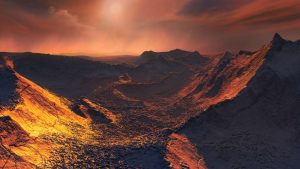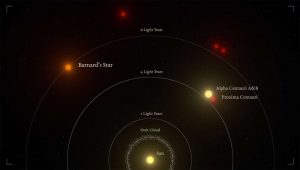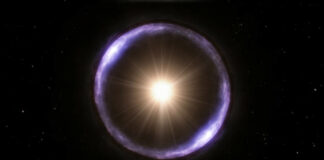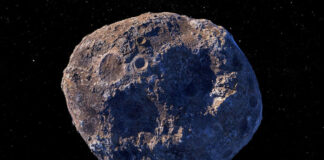NOVEMBER 15, 2018
 Illustration by ESO – M. Kornmesser A dim red star rises over the landscape in this illustration of the newfound planet.
Illustration by ESO – M. Kornmesser A dim red star rises over the landscape in this illustration of the newfound planet.
Just six light-years away, a frozen world seems to be orbiting a small, dim red star. If it’s truly there, the alien planet would at least partly fulfill a fantasy decades in the making, and it could become one of the most promising targets for astronomers keen on getting to know the many worlds beyond our solar system.
The newfound candidate planet, described today in the journal Nature, orbits what’s colloquially known as Barnard’s Star, the closest single star to our sun. The bright Alpha Centauri system, which is two light-years closer and hosts a planet of its own, is actually made up of three stars. By contrast, Barnard’s star is a small red dwarf that’s older than the sun and about a sixth its size. It’s invisible without a decent telescope—the close star wasn’t even discovered until 1916.
Still, Barnard’s Star has long been buttoned into the lore of science fiction, inspiring astronomers to propose the presence of orbiting worlds as far back as the 1960s, and prompting fiction authors to weave tales of adventure around the hidden pinprick of light.
“Barnard’s Star is one of the most famous stars in the sky,” says Ignasi Ribas of Spain’s Institut de Ciències de l’Espai. “People have been looking for planets there forever.”
It’s a small world
Although scientists didn’t confirm the existence of exoplanets until the 1990s, Dutch astronomer Peter van de Kamp had reported three decades earlier that two giant, gassy planets seemed to circle Barnard’s Star, fueling interest in confirming such nearby worlds. Van de Kamp’s planets almost certainly don’t exist, Ribas says—the team would have spotted such large worlds during their more recent observing campaigns. But smaller planets could still shuffle around this nearby star, remaining hidden for decades due to their size.
Even for stars so close to us, spotting smaller worlds is not nearly as simple as aiming a telescope. For some techniques such as searching for planetary transits—as NASA’s prolific Kepler telescope did—it’s an issue of scale: The alignments that let us spot transiting worlds are relatively rare, but Kepler gazed at a patch of sky stuffed with hundreds of thousands of stars, ultimately delivering thousands of discoveries.
Other techniques don’t rely on such alignments but do have limits in the types of planets they can reveal. And in most cases, the myriad signals that reveal the presence of planets get tougher to tease out as those worlds decrease in size, says Caltech’s Erik Petigura.
In 2016, Ribas and his colleagues began aiming the CARMENES instrument, mounted at Spain’s Calar Alto observatory, at Barnard’s Star. They were looking for slight wobbles in the star’s motion—the gravitational fingerprints of an orbiting planet tugging ever so gently on its star. Data sets gathered over 20 years by six different observing instruments had already suggested that such a planet might exist; if so, the data hinted that it likely took 233 Earth-days to complete an orbit.
After 300 additional observations, Ribas and his colleagues were satisfied they had found those 233-day periodic jiggles in the star’s motion.
“Now, we have almost 800 measurements that we’re publishing,” he says. “We got this very clear signal that is there, so we have no doubt that this periodicity is there.”
But their work wasn’t finished. Once they had a signal, the team needed to rule out other possible sources of the jiggle, such starspots or active regions, that might be masquerading as a planet. Many red dwarf stars produce numerous flares and spasms that can look at first like an orbiting planet. But based on observations, Barnard’s Star is exceptionally quiet and well-behaved, which is why Ribas and his team are now reasonably confident in their detection.
“We’re 99-percent sure this is a planetary signal—but 99 is not 100,” he says. “What if the Barnard Star planet is not really there? It will be shot many, many times and people will try to kill it, but that’s how science works.”
 An illustration shows the relative distances of Barnard’s Star and the Alpha Centauri system from our solar system. – Graphic by IEEC/Science-Wave – Guillem Ramisa
An illustration shows the relative distances of Barnard’s Star and the Alpha Centauri system from our solar system. – Graphic by IEEC/Science-Wave – Guillem Ramisa
Heroic effort
Some astronomers, perhaps unsurprisingly, are not as convinced that the team has spotted an extremely nearby exoplanet.
“There is clearly some periodic signal in the data, and it’s reassuring that it seems to be present in multiple datasets,” Petigura says. “However, I would not call it a secure detection.”
What’s more, the two decades’ worth of data bolstering the team’s claim are messy and inconclusive, says Yale University’s Debra Fischer.
“This was a heroic effort,” she says. “However, even with the number of observations that were analyzed here, the putative signal is swamped by measurement errors. Fortunately, next generation spectrographs that will deliver higher fidelity data are now being commissioned and should be able to follow up on this suggested planet candidate.”
If follow-up studies do show the planet is real, the world is at least three times as massive as Earth, and it’s quite cold. The planet’s long orbit around its dim stellar host means that its surface temperature is around -270 degrees Fahrenheit, on average—much too cold to support surface life as we know it.
“If I had to speculate about what this planet would look like, I would say that it could resemble a scaled-up version of some of the moons of Jupiter or Saturn,” Petigura says. “Something like Europa, Ganymede, Callisto, or Titan with large amounts of rock but water ice as well.”
A key question is whether the world is large enough to retain an atmosphere; if so, it could be more like a puffy, mini-Neptune than a solid super-Earth. Even so, Petigura says, “if it had an Earth-like atmosphere, the planet would be far too cold for liquid water to exist on the surface.”
That being said, there are plenty of frozen planets populating the annals of science fiction, like Hoth, an iconic battleground in Star Wars, or Delta Vega, the ice world on which a young Captain Kirk meets the elder Spock in Star Trek. And a planet orbiting Barnard’s Star serves simply as a waystation for space travelers in The Hitchhiker’s Guide to the Galaxy series.
So, even if this candidate planet is too cold for life as we know it, it’s an alluring world that could fit right into the pages of our imagination.
Courtesy/Source: National Geography










































































































